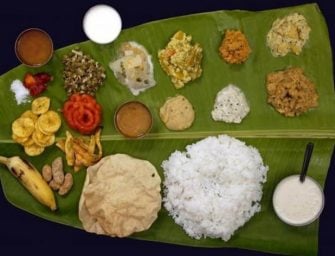Ranging from hand-carved wooden beads to tiny glass seed ones, the traditional beads found in India cover a wide range of styles, materials and treatment processes. The bead art in India dates back to Indus valley civilization and is said to be 5000 years old. People during that age made beads out of silver, gold, clay, ivory and even wood. India is one of the largest bead producers in the world. The beads made in Varanasi are exported in huge quantities throughout the world. The glass beads used today were not found in India until 1700 and were available only in the kingdom of Saurashtra (now southern Gujarat state). With new sets of tools in the modern industry, the artisans have not failed to create newer types of beads with vast colors and imaginative work.
Bead work in Gujarat
Gujarat is highly famous for its bead work. The artisans in Gujarat are specialized in stitching different types of beads on clothes to make it more beautiful and enhance their appeal. The rows of beads are swirled to form geometrical and floral shapes. All these beads are stitched over the clothes with a vibrant energy. The artisans also turn and convert the beads into fabrics by themselves. This kind of work takes a lot of time, skill and energy. These beads can be used to make bags and other articles because they are very firmly and closely stitched together. The stitching is so strong that there is no need of any kind of textile to hold it together.
Kashmiri beads
Kashmiri beads are also known as Bollywood beads. These types of beads are made from manufactured resin, instead of natural lac resin and a mix of marble powder. These beads are hand decorated by using a variety of materials for embellishment such as rhinestones, seed beads, silver plating and mirror chips. Kashmiri beads are very attractive and attention-grabbing works of art as original and unique as the people who create such beads. These beads have metal frame holes, use a single color base, don’t soften on heating and are durable and strong.
Maruti beads
Maruti beads combine silver plated side caps with Kashmiri beads, culminating in a one of a kind creation exclusive to Maruti International. These involve a very time-consuming production process due to their unique and extraordinary design. These beads really amp up the bling and color. The colors and sizes of these beads are vast ranged and spectacular. Whether covered in rhinestones, mirror, glitter or a magnificent combination of these, the lovely creations are excellent as focal beads.
Lac beads
India is also home to the beautiful lac beads. These are from the secretion of small insects living in trees. The material is collected manually by hand, powdered, washed and then heated to form a malleable clay-like substance that can be shaped, colored and glued to other surfaces. A fascinating origin for some beautiful beads. Silver, clay and terracotta beads, as well as carved wooden, soap stone and bone beads, these are all made by hand, with designs that range from simple geometric shapes to intricate geometrical work. Lampwork beads form a major section of India’s bead exports, with delicate small designs and a variety of colors – each one is unique and cannot be replicated. Indian beads are used in jewelry worldwide, but that’s not all they are good for. These magnificent decorations adorn everything from everyday clothing, shoes and bags to festive and heavy bridal wear. No bride in India can resist a sari or lehenga with gorgeous aari or zari work embroidery – and colorful crystals, glass or pearls beads that sparkle in the light.
Rudraksha beads
A rudraksha bead grows on the Eliocarpus ganitrus tree as a seed and it plays a very important role in lives of sanyasis or spiritual seekers. Sadhgurus explain different varieties of these beads and their benefits, including five faced beads (panchmukhi) and single faced beads (ek mukhi). Usually these beads are used as a mala by stringing them together on a string. Traditionally they string 109 beads in a mala with the 109th bead called as Bindu. Sadhgurus believe that there should always be a Bindu in the mala else the energy would become cyclical and sensitive people using that mala could become dizzy because of that. Whenever a mala is strung together, it is considered best to string it on a cotton or silk thread. The rudraksha mala can be worn all the time even during bath or sleep. For those people who are on the move to different places regularly, rudraksha mala is a very beneficial thing. It is believed to make a protective energy shield around that person which protects him from the surrounding negative energies. Another fact about rudraksha bead is that it moves anticlockwise if held above a poisonous drink or negative pranic food and clockwise if held above a clean drink or a positive pranic food.
Meenakari beads
The traditional process of making meenakari bead starts with the designer, then moves on to the goldsmith and then to the engraver who sends it to the enamellist. From there, it moves on to the polisher before going to the stone setter and finally to the stringer. All of these are a part of the important chain that leads to the production of a single meenakari bead. But due to unavailability of experienced and good artisans, a single experienced worker does many parts himself in a chain. The meenakars make intricate designs on the surface of plain soft gold bead with a metal wire or a stylus and then fill in the colors. The meena (bead) is then heated in furnace for the fusion of colours with the base metal to become one with the surface. After this, the meena is rubbed gently and washed with tamarind or lemon to highlight different colors on its surface.
Tribal beads
Capturing the essence of different tribal communities in India, the tribal beads are usually made using natural materials such as wood, ivory, iron and sometimes even bones and animal teeth. Often these beads are enameled in different hues using natural colors and then beautified by using a variety of carving styles by the use of metal wires, sharp animal teeth and knives. Sometimes even chunks of metals like silver, copper or brass are embellished with precious and semi-precious stones to create earthy tribal jewels. The tribals make strings for these beads by using animal hair, fine strips of leather and other naturally available threads.
Significance of beads in India
Beads have certain religious and spiritual significance in India. A japa mala is a set of beads which is commonly used by Buddhists and Hindus for various prayer purposes. A japa mala has usually 108 beads strung together in it but other variations with a different number of beads are also there. These malas are used while chanting, reciting or during repetition of a mantra mentally to keep count. Mantras are recited hundreds of times and sometimes even thousands of times; these malas are used so that the person can focus on the sound and meaning of the mantra rather than just keep focusing on the number of repetitions. If more than 108 repetitions of a mantra is to be done then in Tibetan tradition, they count out a specific number of rice grains and put them in a bowl. After every 108 repetitions, one grain is removed from the bowl until the bowl is empty.


